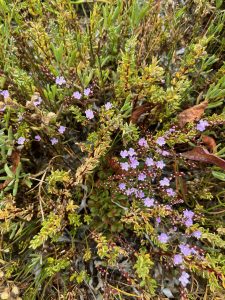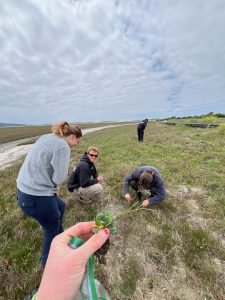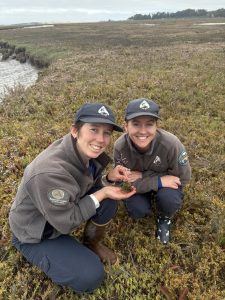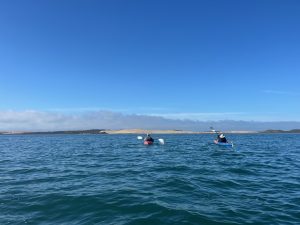Morro Bay’s salt marsh is a unique habitat that serves as a home for species like migratory birds and steelhead trout. This area also acts as a crucial natural buffer that helps protect our communities and infrastructure from coastal flooding. When non-native invasive species grow rapidly and outcompete native species, they can degrade the sensitive habitat that our coastal communities and wildlife rely on.
Over the past few decades, invasive European sea lavender (Limonium duriusculum) has been a focus of salt marsh restoration in Morro Bay and other California tidal marsh ecosystems like San Francisco Bay and Carpinteria marshes. The plant was first discovered in Morro Bay in 2011 and was hand removed by partners at State Parks and the Land Conservancy of San Luis Obispo. This rapid response helped keep European sea lavender at more manageable levels compared to other marshes.
In 2021, the project was passed on to the Estuary Program in partnership with State Parks with the goal of completely eradicating European sea lavender from Morro Bay. For more details on this effort, check out our previous blog.
Why Is Invasive Sea Lavender a Threat?
Each mature European sea lavender plant can annually produce hundreds to thousands of seeds that can be transported by tides, survive up to two weeks in salt water, and remain viable in the soil for at least five years (Cal-IPC 2017). This makes the population challenging to control once plants have seeded. Due to their high salt tolerance, plants can quickly get established and crowd out native species like California sea lavender (Limonium californicum) and federally endangered plants like salt marsh bird’s beak (Chloropyron maritimum ssp. maritimus). Displacement of native vegetation can greatly diminish habitat quality of the marsh and disrupt the ecosystem.

Involving Our Community in Restoration
To fully eradicate European sea lavender from Morro Bay, Estuary Program staff work with a team of volunteers and partners from State Parks and the Watershed Stewards Program (WSP). WSP is a California Conservation Corps program in partnership with AmeriCorps. Our team works together to survey salt marsh habitat and hand remove European sea lavender.
Locations and number of European sea lavender found are mapped using high-accuracy GPS units to track concentrations of the invasive plant over time. We visit sites with recent European sea lavender sightings approximately every month and conduct a baywide survey every July for any new infestations. The baywide survey requires walking the majority of native sea lavender habitat throughout the salt marsh. It equates to over 18 miles of hiking every July. Over the past four years we have had fourteen volunteers contribute over 130 hours for these surveys. By involving more community members and partners in this work, we have successfully removed over a thousand European sea lavender plants from the salt marsh.

Adaptive Management Approaches
Effective invasive species management requires adapting practices in response to on-the-ground observations and improved understanding of the invasive organism’s biology. Most of the plants flower in the May to August timeframe. Their seeds can spread more widely during summer high tides. To account for these conditions, we increased our surveying frequency from monthly to weekly during summer months. Weekly surveys focus on areas where our mapping results show higher concentrations of invasive sea lavender that are likely to be a seed source.
The Estuary Program and our partners and volunteers will continue these efforts to help protect and restore native salt marsh habitat for species and community benefits.

How Can You Help?
- Volunteer for invasive species removal or habitat restoration projects. Fill out a Volunteer Interest form on our website and follow the Estuary Program’s Eventbrite page to be notified of future events. Check out other local organizations in your area.
- Report any sightings of invasive species like European sea lavender to community science platforms like iNaturalist or CalFlora.
- Learn more about invasive plant species in your yard or local community by visiting the California Invasive Plant Council’s website.
- Learn how to prevent the spread of invasive species during your outdoor adventures from PlayCleanGo.
- Select native or non-invasive plants for your garden.
- Use only certified “weed-free” forage, hay, seed, mulch, soil, and gravel.
- Check out the new WeedCUT tool to learn more about how to manage invasive species.

Our dedicated volunteers access some of the sea lavender monitoring sites via kayak.
References
California Invasive Plant Council. 2017. Plant Assessment Form—Liminium duriusculum. https://www.cal-ipc.org/plants/paf/limonium-duriusculum-plant-assessment-form/
Help us protect and restore the Morro Bay estuary!
- Donate to the Estuary Program today and support our work in the field, the lab, and beyond.
The Estuary Program is a 501(c)3 nonprofit. As a result, we depend on funding from grants and generous donors to continue our work. - Support us by purchasing estuary-themed gear from ESTERO. This locally owned and operated company donates 20% of proceeds from its Estuary clothing line and 100% of Estuary decal proceeds to the Estuary Program. Thank you, ESTERO!
- Purchase items from the Estuary Program’s store on Zazzle. Zazzle prints and ships your items, and the Estuary Program receives 10% of the proceeds.
- Subscribe to our seasonal newsletter: Between the Tides!
- We want to hear from you! Please take a few minutes to fill out this short survey about what type of events you’d like to see from the Estuary Program. We appreciate your input!